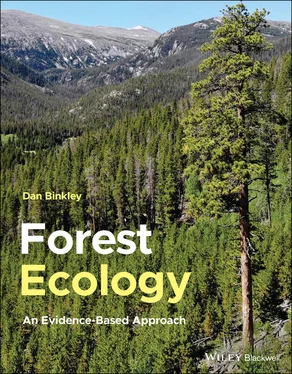Dan Binkley - Forest Ecology
Здесь есть возможность читать онлайн «Dan Binkley - Forest Ecology» — ознакомительный отрывок электронной книги совершенно бесплатно, а после прочтения отрывка купить полную версию. В некоторых случаях можно слушать аудио, скачать через торрент в формате fb2 и присутствует краткое содержание. Жанр: unrecognised, на английском языке. Описание произведения, (предисловие) а так же отзывы посетителей доступны на портале библиотеки ЛибКат.
- Название:Forest Ecology
- Автор:
- Жанр:
- Год:неизвестен
- ISBN:нет данных
- Рейтинг книги:5 / 5. Голосов: 1
-
Избранное:Добавить в избранное
- Отзывы:
-
Ваша оценка:
- 100
- 1
- 2
- 3
- 4
- 5
Forest Ecology: краткое содержание, описание и аннотация
Предлагаем к чтению аннотацию, описание, краткое содержание или предисловие (зависит от того, что написал сам автор книги «Forest Ecology»). Если вы не нашли необходимую информацию о книге — напишите в комментариях, мы постараемся отыскать её.
Forest Ecology
An Evidence-Based Approach Forest Ecology: An Evidence-Based Approach
Forest Ecology: An Evidence-Based Approach
Forest Ecology — читать онлайн ознакомительный отрывок
Ниже представлен текст книги, разбитый по страницам. Система сохранения места последней прочитанной страницы, позволяет с удобством читать онлайн бесплатно книгу «Forest Ecology», без необходимости каждый раз заново искать на чём Вы остановились. Поставьте закладку, и сможете в любой момент перейти на страницу, на которой закончили чтение.
Интервал:
Закладка:
Table of Contents
1 Cover
2 Title Page
3 Copyright Page
4 Dedication Page
5 PrefaceHow Do We Come to Understand Forests? How Confident Should You Be? All Forest Ecology Fits Into a Framework and a Method A Picture May Be Worth 1000 Words, But a Graph Can Be Worth Even More The Most Important Points to Understand from Figures B and C Are Not About Precipitation or Temperature Confidence Bands Around Trends Come in Two Types The Stories in This Book Have Two Pieces, Told in Three Ways Forests Are Complex Systems That Are Not Tightly Determined
6 Acknowledgements
7 CHAPTER 1: The Nature of Forests Forest Ecology Deals with Individual Trees Across Time Many Processes Occur in a Tree Every Hour Tree Physiology Follows Daily Cycles Trees Must Cope with Seasonal Cycles Through Each Year Trees Grow and Reproduce at Times Scales of a Century The Story of Forests Is More than the Sum of the Individual Trees, Because Interactions Are So Strong The Coweeta Forests Aren't the Same as Two Centuries Ago Across Dozens of Generations of Trees, Almost Everything Changed at Coweeta The Futures of the Tree and the Forest Will Depend on Both Gradual, Predictable Changes and Contingent Events Ecological Afterthoughts: Is a Forest an Organism?
8 CHAPTER 2: Forest Environments Climate Influences Where Forest Occur, and How They Grow Warmer Forests Have More Species of Trees Chemical and Biological Reactions Go Faster with Increasing Temperature Temperature is the Balance Point Between Energy Gains and Losses All Objects Shine; Hot Objects Shine Brightly Incoming Sunlight Decreases in Winter and at Higher Latitudes Forests Receive Shortwave Sunlight, and Shine off Longwave Radiation Temperatures Decline with Increasing Latitude Temperatures Increase at Lower Elevations Temperature Variation Over Time, and Across Space, Strongly Influences Forest Ecology Temperature Strongly Influences Phenology and Growth Forests Use Very Large Amounts of Water Water Flows Down Gradients of Potential, Which Sometimes Means Going Up Wind Shapes Trees and Forests Events and Interactions Are More Important Than Averages and Single Factors Fires Depend on Temperature, Water, Winds Droughts Affect Trees, Beetles, Forest Structure and Fire Intensity Weather Events Can Matter More than Averages Ecological Afterthoughts
9 CHAPTER 3: Evolution and Adaptation in ForestsWhat's in a Name? The Core Idea of Evolution Is the Combination of Variation, Failure, and Innovation Darwin Could Not Explain Why Variations Occurred, or Why They Were Passed on to Offspring Does Selection Work on Species or on Genes, or Is This Only a Chicken‐and‐Egg Question? Biology Operates from a Simple Story of DNA to Incredible Complexity of Proteins and Biochemistry Why Are There Only Two Species of Tulip Poplar, and Why Are They 12 000 km Apart? Tall Growth Requires Strong Stems The First Trees from Seeds Were Gymnosperms Collaboration with Insects Helped Angiosperms Take over the Planet The Highest Diversity Is in Tropical Rain Forests Do all Trees Need to Have Trunks? Some Broadleaved Trees Make Fertilizer Out of Thin Air What's the Largest Tree in the World? History Has No Need to Repeat Itself Critchfield Spruce Melted Away at the End of the Last Ice Age Ponderosa Pine Went from Obscurity to Prominence in Just a Few Thousand Years Eastern Hemlock Has Had a Dynamic History of Up and Down Almost all the Animal Species Are Missing from Temperate and Boreal Forests Climate, Animals and Fire Interact Across Forest Generations Modern Forests Are Changing Faster Than Ever, on a Global Scale Ecological Afterthoughts
10 CHAPTER 4: Physiology and Life History of Trees Biological Energy Is About Moving Electrons Forest Energy Comes from Sunlight; Wood Comes from Thin Air Why Are Leaves Green? Leaves Are Not Always Green Carbon Uptake Is the Second Half of Photosynthesis Growth Happens After Photosynthesis – Sometimes Long After Trees Do Not Live by Carbon Alone Photosynthesis and Growth Depend on Acquisition of Resources More Leaves Means More Light Capture, up to a Point One Square‐Meter of Leaves Has a Mass of 50–150 g Each Square Meter of a Forest has Multiple Layers of Leaves above Large Trees Depend on Large Roots Networks of Fine Roots Permeate Soils Do Roots Take Up Water and Nutrients? Trees (and Mycorrhizal Fungi) Obtain Nutrients by the Interaction of Mass Flow and Diffusion Life History Is the Story of Going from Seed to Mature Seed‐Producing Tree Tree Seeds Range in Mass from Smaller than a Flea to Larger than a Mouse Why Is the Understory of a Forest a Tough Place for Small Trees to Thrive? All Good Summers Come to an End Most Trees Die Young Reproduction Is the Beginning and the End of Life History Stories Ecological Afterthoughts: What Benefit Comes from Aspen Having Chlorophyll in Its Bark?
11 CHAPTER 5: Ecology of Wildlife in Forests Many Species of Trees Coevolved with Animals as Seed Dispersers Some Animal Species Specialize in Eating Trees Livestock Grazing and Browsing has been a Core Part of People’s Livelihoods Through History Was Aldo Leopold Right About the Kaibab Deer Herd? Wildlife Population Dynamics Occur Within Complex Ecological Systems Moose and Wolves Established New Populations on Isle Royale in the Early 1900s The Cycles of Snowshoe Hares and Lynx Repeat, but They Are Far from Simple Patterns and Processes of Wildlife Population Dynamic Shift Across Space and Time Good Ideas Without Good Evidence May Be Unreliable, or Wrong Strong Evidence Comes from Comparisons of Treatments at the Same Point in Time Ecological Afterthoughts
12 CHAPTER 6: Forest Soils, Nutrient Cycling, and Hydrology Forests Need Soils for Physical Support Soils Here Are Different from Over There, and Soils Now Are Different from Soils Then Organic Matter is the Top Feature of Soils Clay Content Comes in Second to Organic Matter Soils Breathe The Variety of Soils Is Parsed into Soil Taxonomic Groups Soils Differ in Age, Even if Most Don't Have Birthdays Trees Affect Soils Decomposition Reverses Photosynthesis and Nutrient Uptake Almost all Forest Biodiversity Is Found in the Soil Leonardo da Vinci Couldn't Figure out How Water Got to the Top of Mountains The Atmosphere Holds Only a Few Days of Precipitation Forest Water Budgets Begin with Precipitation Water Use by Forests Can Be Measured Across a Range of Scales Trees Use Most (or All) of the Water George Perkins Marsh (and Everyone Else) Was Wrong About the Effect of Forest Cutting on Water Reliable Generalizations Require Evidence from More than One Case Nutrients Make Life Possible Nutrients Come From the Atmosphere and From Rocks Biogeochemical Cycles Are Complex Decomposition is the Centerpiece of Nutrient Cycling in Forests Nutrient Losses Are Chronic and Episodic Ecological Afterthoughts: Consequences of a Warmer World for Snow, Streams, and Forests
13 CHAPTER 7: Ecology of Growth of Trees and Forests Forests Are Small and Large, and Growth Is the Key Process Driving Increases Growth is Examined in a Variety of Ways Yield Tables Were an Early Example of Parsing Variation in Forests Across Landscapes Patterns in Yield Tables Were Explained Based on “Growing Space” Production Ecology Parses Growth into Ecophysiological Factors Constrained by Mass Balance Forest Growth Is a Function of Resources in the Environment, Resources Acquired, and Efficiency of Resource Use The Growth of a Forest is the Sum of the Growth of All the Trees Large Trees Usually Grow Faster than Small Trees in the Same Forest Dense Forests Have the Highest Growth Rates Forest Growth Peaks at a Young Age and Then Declines, but Not the Growth of the Biggest Trees in the Forest Forest Growth Changes over Time, Not Just with Age Neighbors Influence the Growth of Trees How Might a Mixed‐Species Forest Grow Faster than a Single‐Species Forest? Mixed‐Species Forests Usually Cannot Match the Growth of Fast‐Growing Monocultures When a Species Increases Resource Supplies, Mixtures May (or May Not) Outperform Single‐Species Forests The Growth of Mixed‐Species Forests Changes over Time Mixed‐Species Forests Are not Only About Growth Interactions Between Species Understory Vegetation is Important in Most Forests Mortality Gets the Final Word on Forest Production Death is Not the End of the Story for Trees Ecological Afterthoughts: Is it Better to Remove Small Trees or Large Trees When Thinning a Forest?
Читать дальшеИнтервал:
Закладка:
Похожие книги на «Forest Ecology»
Представляем Вашему вниманию похожие книги на «Forest Ecology» списком для выбора. Мы отобрали схожую по названию и смыслу литературу в надежде предоставить читателям больше вариантов отыскать новые, интересные, ещё непрочитанные произведения.
Обсуждение, отзывы о книге «Forest Ecology» и просто собственные мнения читателей. Оставьте ваши комментарии, напишите, что Вы думаете о произведении, его смысле или главных героях. Укажите что конкретно понравилось, а что нет, и почему Вы так считаете.












